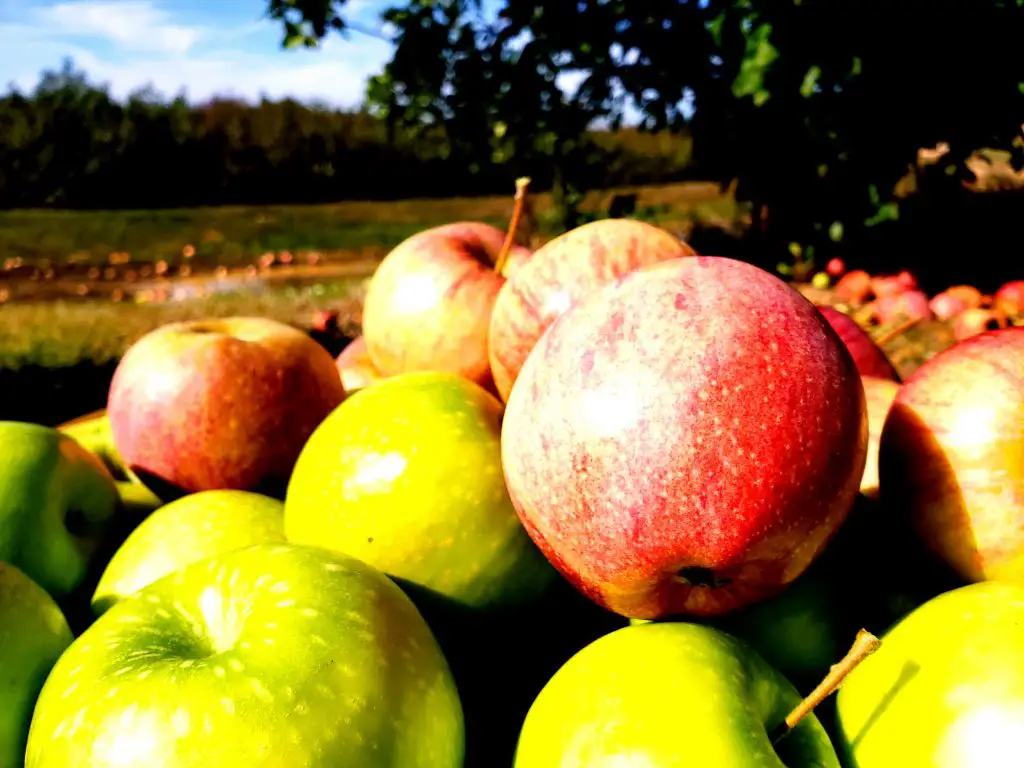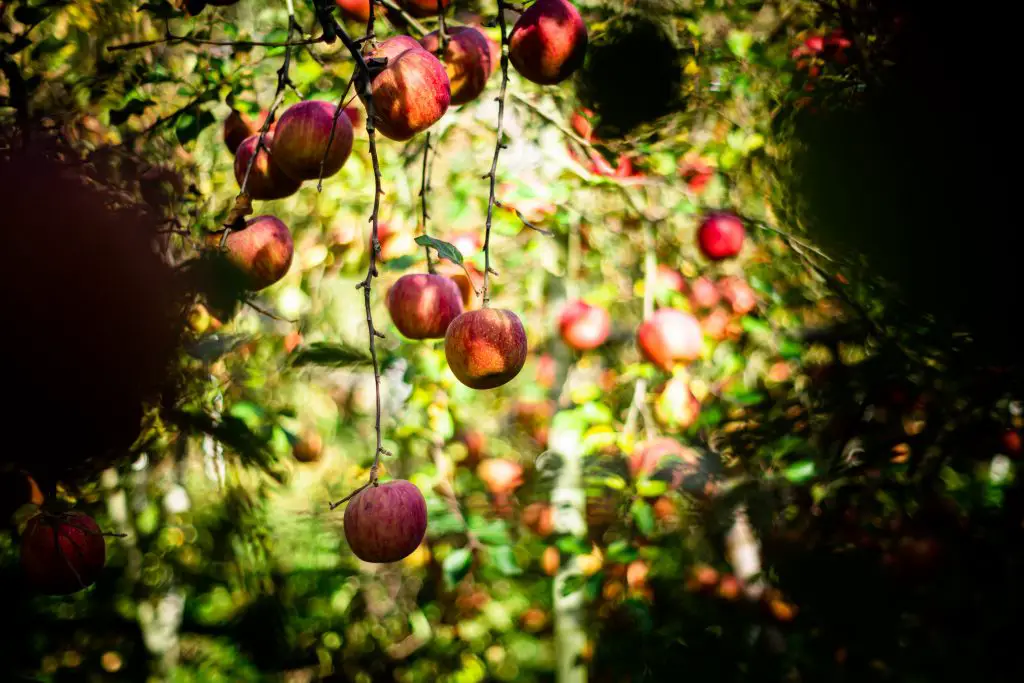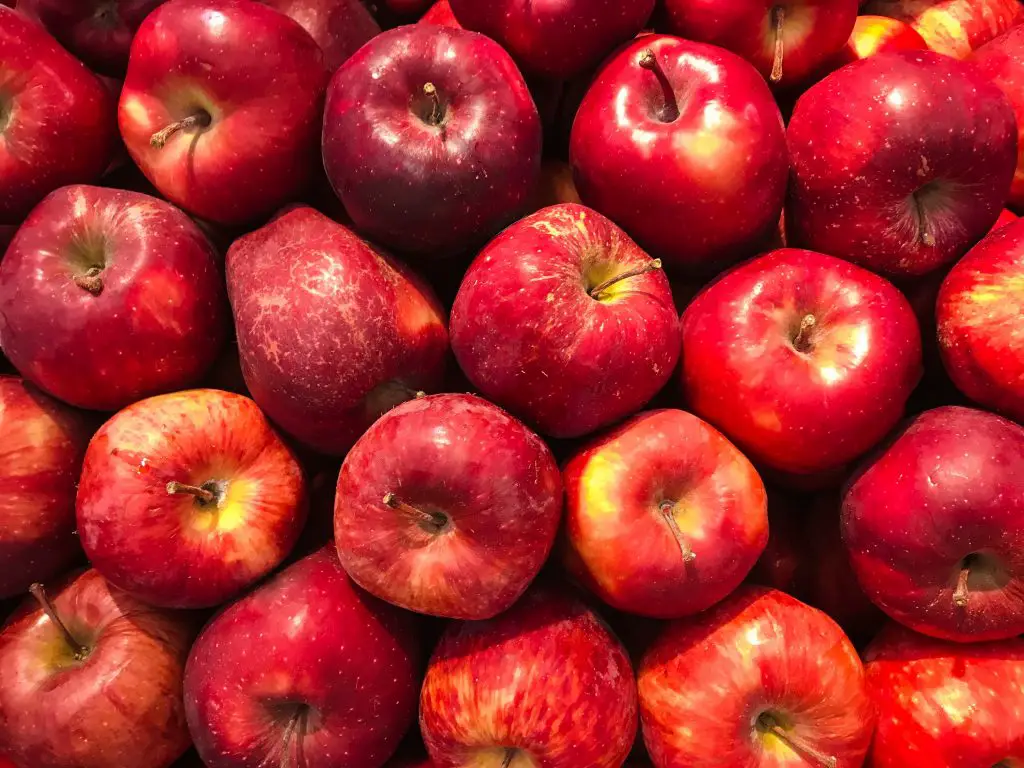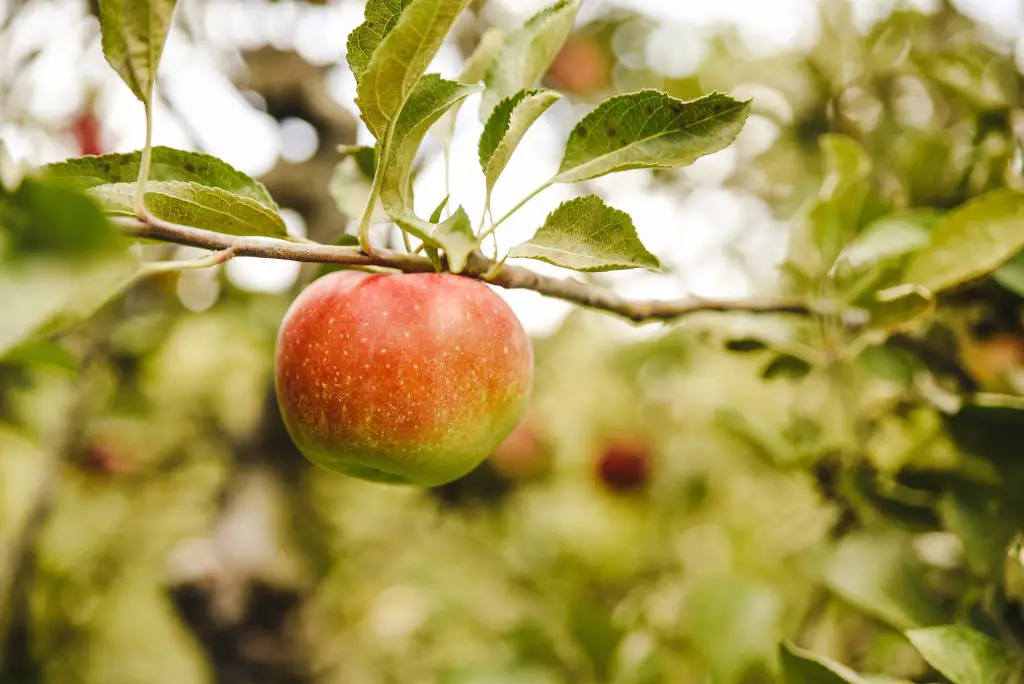How Many Apples Does One Tree Produce? Apples are one of the most popular fruits in the world. There are over 7000 varieties to choose from that are grown all over the world. Apples are available in Standard, Semi-Dwarf, and Dwarf forms depending on the rootstock selected. So how much does an Apple tree yield?
The yield for apple trees varies widely depending on the variety, rootstock, and age of the tree. Typically a mature standard apple tree will yield 500 lbs (226 kg) of apples, a Semi-Dwarf will yield 250 lbs (113 kg) and a Dwarf variety will yield 40 to 100 lbs (18 to 45 kg). For the Apple tree to reach full production it will require at least 7 to 8 years and sometimes much longer.
However, most varieties will produce their first crop after 2 to 4 years, which for most trees will be only a few pounds in the first year. Trees grafted to Dwarf or Semi-Dwarf rootstocks tend to produce fruit faster than standard apple trees.
In terms of size, Dwarf rootstocks limit the size of the tree to around 6 to 12 feet tall (1.8 to 3.6 m) compared to a full-size tree which can reach a size of 30 ft (9 m) tall and 30 ft (9 m) wide. For home gardeners, the most practical choice is a Dwarf tree as it takes up less room, is easier to manage and harvest the fruit.

Are There Different Types Of Apple Trees?
Apple trees can generally be grouped into early, mid-season, and late Apples. Early and Mid-season Apples tend to be referred sometimes as Eating Apples sometimes because they do not store well need to be eaten relatively quickly.
The late-season Apples tend to be referred to as cooking apples however, this term can be confusing because many Apples have a variety of uses. Granny Smith Apples, for example, are commonly eaten fresh and also used in cooking. Late season apples can be stored for several months in a cool dark location.
What Climates Can Apple Trees Be Grown?
Apple Trees are suitable to be grown in Zones 3 to 9 with some varieties even capable of tolerating temperatures as low as -40°F (-40°C). However, for an Apple tree to successfully produce flowers and fruit the tree needs to be exposed to a period of cold, which is often referred to as chill hours. This is the number of hours that a tree needs to be exposed to temperatures under 45°F (7°C).
The number of chill hours required varies with different varieties between 300 and 1000 hrs, however most varieties require between 500 and 1000hrs. To estimate the chill hours in your own climate and therefore the suitability of a given variety, take the average temperature in your coldest month and compare it to the table provided below.
Chill Hours Average Temperature For Coldest Month
0 19.7°C (67.5°F) – No Chill
300 15.5°C (59.9°F) – Low Chill
330 15.3°C (59.5°F) – Low Chill
450 14.0°C (57.2°F) – Medium Chill
500 13.6°C (56.5°F) – Medium Chill
520 13.1°C (55.6°F) – Medium Chill
600 12.7°C (54.9°F) – Medium to High Chill
800 10.2°C (50.4°F) – High Chill
1100 7.9°C (46.2°F) – High Chill
1250 0.0°C (32.0°F) – Very High Chill

Do You Need More Than One Apple Tree To Produce Fruit?
In most cases, Apple trees require a second tree in order to bear fruit. The trees do not need to be planted right next to each other to cross-pollinate, though this is advantageous. However, as long as the tree is somewhere nearby in a neighbour’s yard or the general vicinity you should get fruit.
In addition to this, it is also necessary to have two trees that flower at the same time. To aid in the identification of suitable pollination partners Apple varieties are grouped on the basis of the time flowering occurs. Trees are grouped from A to D in order of flowering, ie The earliest group of trees is designated group A and the latest flowering trees are designated group D.
Trees are capable of cross-pollinating any tree within the same group or those in adjacent groups. For example, a tree in group B can pollinate trees from groups A, B, or C because their flowering periods overlap.
There are some varieties that exist that can self-pollinate to some degree however these varieties still benefit from the presence of a second fruit tree as it will generally increase the yield. Some of the varieties that are listed as self-fertile include; Alkmene, Cox Queen, Granny Smith, Grimes Golden. Partially self-fertile varieties include Cortland Egremont, Russet Empire, Fiesta, James Grieve, Jonathan Saint, and Edmund Russet Yellow Transparent. A list of common varieties with their harvest period and pollination group are provided below for reference.

How To Grow Apple Trees
Apple trees long-lived trees that are relatively easy to grow. To start them off it is best to plant them in late winter or early spring because it allows the tree to become established before the summer. The other advantage of planting trees at this time of year is that they can be purchased as bare-rooted plants which are significantly cheaper than purchasing potted plants.
Having purchased a tree the next important step is to select a position for the tree. Apple trees, like all flowering plants, prefer a warm location that gets at least 6 to 8 hours of direct sunlight per day.
Once a planting location has been selected the next important step is to prepare the soil. Apple trees prefer soil that is rich with organic matter well-draining and slightly acidic, a pH between 6 and 7 is ideal. The easiest way to measure the soil pH is to used a pH meter as they are cheaper than a pH kit with strips. The particular meter we recommend also measures moisture and light levels which is useful when managing your garden, click here to see the latest price on Amazon.
If the soil is lacking in nutrients, it may be necessary to add compost to the soil. If the pH is outside the desired range it can be adjusted up with lime and down with sulfur. Any additions to the soil should be dug into the soil before creating the planting hole.
Once the planting hole has been created it is best to put support structures in place before the tree is planted. It is recommended that a heavy garden be used to support the tree in the first few seasons, particularly in locations with windy conditions. You may also consider espaliering the tree as it will reduce the space required, to read more about how to espalier trees click here.

Once the support structures are in place position the tree in the hole to ensure that it is at the same level in the ground as it had been originally. This means that the graft union should be approximately 2 inches (5 cm) above the ground. Then backfill the hole with soil ensure that it is packed firmly around the root-ball to avoid any chance of air pockets forming.
Water the tree well and cover the areas surrounding the tree with a thick layer of organic mulch, 2 to 4 inches is ideal. Be sure not to let the mulch rest against the trunk as it has the potential to cause collar rot.
At this stage, the tree needs to be pruned to ensure that it develops a vase-like shape as this will allow sunlight and air to penetrate the structure. This aids in the formation and ripening of fruit and reduces the chances of a fungal disease taking hold.
To create this shape trim the branches 1 to 2 ft (30 to 60 cm) above where they fork. Ideally, the cut should be made just above an outward-facing bud. Cuts made in winter will encourage new growth of the tree and the formation of new wood. Those cuts made in Summer restrict growth,
Once the pruning is complete and you are happy with the shape of the tree use garden ties made of soft flexible material to firmly attach the tree trunk to the support structure.
In the first growing season after planting, when the tree is still just establishing its root system the tree is particularly susceptible to drying out. As a result of this necessary to ensure that the tree remains moist by regularly watering it, particularly in summer when there is often little rain.
Additionally, it is recommended that fertilizer be added in early spring to ensure that there are adequate nutrients throughout the growing season.
Each year Apple trees should be pruned in summer to maintain the shape and remove and unwanted branches that affect the structure. The winter prune should be completed to encourage new growth. To maintain the vase-like shape the first step is to remove inward-facing branches to ensure that the light and air are able to enter the structure of the tree easily, along with any diseased or damaged branches. The height of the remaining branches should be reduced to 1 ft (30 cm) above any forks to continue to develop the structure.
However, once the structure of the tree has developed sufficiently it will be necessary to maintain the tree at a height that allows the fruit to be harvested easily.
